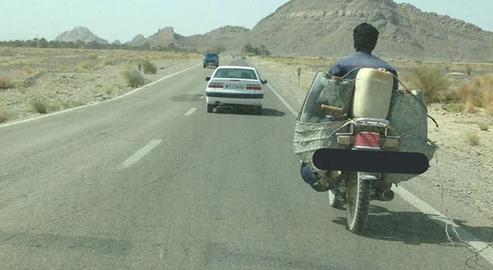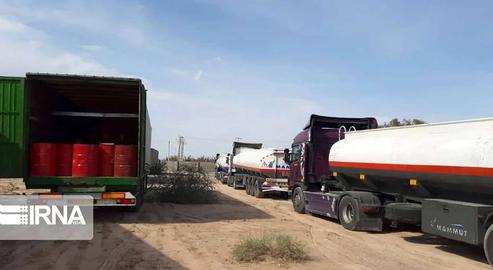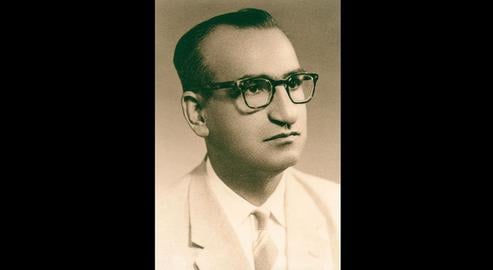Demonstrations against the killing of Baluch fuel carriers have continued across Sistan and Baluchestan amid a heavy security presence in some cities. Reports have surfaced of clashes between locals and armed officers, and the number of killed and wounded remains unclear.
Protests and clashes have been reported in the cities of Zahedan, Saravan and Iranshahr and Mirjavah, the villages of Sarjangal and Ghaleh-Bid and Korin District. Mobile access to the internet is cut off across most parts of the province and landline internet access has also been disrupted. As well as detaining some protesters, the security forces have also reportedly sent threatening text messages to citizens.
How Did the Protests Start?
The flare-up of demonstrations this week began with a widely-publicized shooting on Monday, February 22. Officers thought to be affiliated to the Revolutionary Guards opened fire on fuel carriers in the border area near Saravan, known as Bam Posht and Askan.
Islamic Republic officials have since claimed that two people were killed in the incident, but the Baloch Activist Campaign published the names of ten people who had been killed and five who were wounded on the same day. The attack sparked outrage in Saravan and family members of those killed stormed the governor's offices on Tuesday, while another group of protesters marched on the Shamsar checkpoint.
The government has so far issued contradictory statements on the unrest. Initially officials claimed a "non-violent" incident had taken place in the province and had since ended, but later back-tracked, stating “at least one” demonstrator had been killed.
Violent repression of the protesters in Saravan led in turn to the spread of anger and clashes in other parts of the province. For his part the governor of Zahedan, Abuzar Mehdi Nakhaei, claimed that the outcry had been sparked by "fake" statistics about deaths at the Shamsar checkpoint. The governor also threw his weight behind repressive actions by the security forces on Wednesday evening, calling protesters in Ghaleh-Bid and Korin “armed bandits” who "intended to capture Korin Police Station".
Molavi Abdol Hamid, the Sunni Friday Imam of Zahedan and the province's most prominent religious figure, strongly condemned the shooting of the Baluch fuel carriers on Wednesday and called them "martyrs." He also called for an "impartial investigation" into the incident, urging people to control their emotions.
No Change in the Islamic Republic’s Response to Unrest
Throughout the history of the Islamic Republic, the script for officials seeking to neutralize dissent has remained more or less unchanged: give no clear account of what happened; affirm the people's right to protest; and finally, warn the "honorable people" to distance themselves from the "insurgents".
Simultaneously, protesters are rounded up and detained. Their story becomes intentionally convoluted, with new elements added and others omitted, while the language of violent repression tells “the people” all they truly need to know.
In the case of Saravan, the deputy governor first said that the shooting had taken place on Pakistani soil, leaving one person dead. Another person, he then said, was killed in the incident at the Shamsar checkpoint, and it "ought to be investigated".
Both the deputy governor and the governor of Saravan, Saeed Tajlili, had adopted a non-threatening tone in the first new hours of the unrest, and even displayed empathy with the protesters. But Tajlili also said that officials had shown restraint in the face of a 500-strong attack on the governor's offices, and “without using any violence ... we called on the people to calm down and the people left".
He even claimed that evening: "The city is completely calm and nothing has happened after yesterday's events." A statement that, it quickly transpired, was a complete lie.
The authorities have now resorted to straightforward intimidation. Abuzar Mehdi Nakhaei, the governor of Zahedan, called the protesters "armed bandits" and "paid mercenaries" who had not achieved “their sinister goals".
Who are the Fuel Carriers of Sistan and Baluchistan?
Fuel carriers, or as the locals call them, "fuel movers", are those who out of deprivation and a lack of other opportunities have resorted to conveying gasoline and diesel fuel from Iran to Pakistan. Their exact number is unknown.
The average unemployment rate in Sistan and Baluchestan has always been worse than average in Iran, and sometimes the worst of all 31 provinces. Smuggling fuel into neighboring countries to the east is a lucrative business for those involved in its organization, but the locals from Sistan and Baluchistan, who operate as drivers and truckers, still earn very little money from this risky trade. Photographs taken by the Iranian photographer Sadegh Souri have previously shed light on their precarious daily lives, as well as the amputations that some have undergone after being shot at in cold blood by border patrols.
In the face of would-be political upheaval, the Islamic Republic has always sought to sow confusion around the narrative of events from one place to the next – to the point of highlighting entirely irrelevant elements and components. This tactic has already been clearly demonstrated in the Saravan affair. In the aftermath of the shooting, some supporters of the regime dismissed the news on the basis that the victims were “smugglers”.
What is a Smuggler?
When one of the most important officials in the Islamic Republic’s fight against economic corruption has already said that 95 percent of smuggling takes place through the official customs organization, whether or not these deprived people can be called smugglers is a moot point.
And for their part, fuel carriers are not even among the five percent who rely on unofficial sources. The involvement of the Revolutionary Guards in the sprawling and widespread smuggling operations to and from Iran was a secret in the past, but has now been acknowledged by at least two Iranian presidents. Smuggling fuel to Pakistan is profitable, but the fuel carriers themselves earn just 8,000 to 12,000 tomans every time they take the risk and embark on the exhausting journey across the border and back. The rest of the enormous profits find their way directly into the coffers of the IRGC.
Ironically, this is the same body that ensures it is seen to be confronting the smugglers. It is also the same one that acts to block any real route out of deprivation in Sistan and Baluchistan. In its recent propaganda, the IRGC has said it intends to alleviate poverty in the province through the Razzagh Plan – but a review of the details of this scheme show otherwise.
In 2011, then-President Mahmoud Ahmadinejad's government instructed the Ministry of Oil to sell petroleum products to the residents of border villages at subsidized prices by creating official fuel markets at the borders. The implementation of this plan began in a limited way in 2013, but confined to four provinces and faced with fierce opposition from the IRGC. In time, it fell apart under that pressure, despite the support it had received from experts.
The IRGC Headquarters finally unveiled its own project, called the Razzagh Plan, in 2018. Mohammad Marani, the former commander of the IRGC Ground Force’s Quds Base, said two years ago that only certain individuals whose “poverty had been confirmed” by the IRGC would be permitted to carry fuel from now on.
By implementing this plan, on the one hand, the Revolutionary Guards would be able to exploit the most deprived groups to achieve the lucrative benefits of smuggling. On the other hand, it cements the government's strategy of religious discrimination and the exclusion of Sunnis.
The Statistical Center of Iran’s own figures show the disastrous outcome of decades of neglect of this province. Last autumn the economic participation rate of this province stood at just 32.9 percent, while the employment rate was 29.9 percent: the lowest of all provinces in Iran. Those who have resorted to smuggling in these dire circumstances have done so not only predictably, but with the full backing of the state.
Related coverage:
Why Baluchis are Facing Death to Escape Poverty
Iranian Baluchis Protest Against the Shooting of Impoverished Fuel Smugglers
How Did the Fires of Protest in Saravan Ignite?
visit the accountability section
In this section of Iran Wire, you can contact the officials and launch your campaign for various problems


























comments